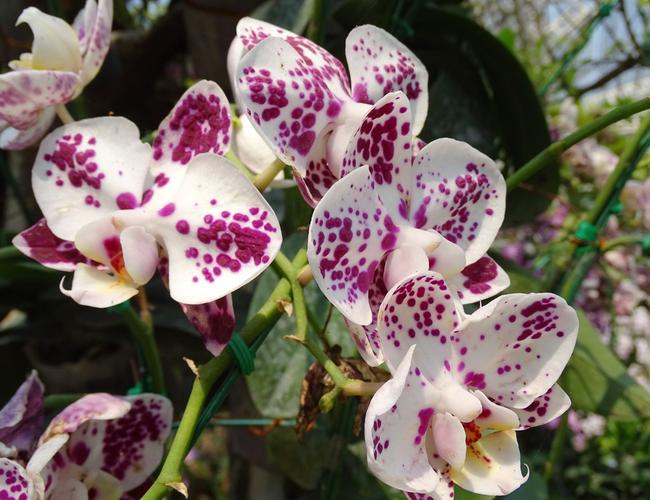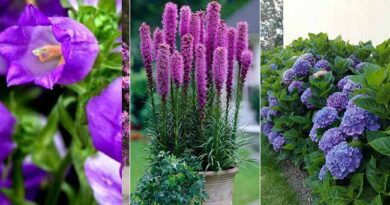8 Things Your Orchids Need in November If You Want Early Spring Blooms
Orchids always look so classy sitting there like they’re effortless… but anyone who’s actually tried growing them knows the truth—they’re kinda dramatic. They bloom only when the conditions are right, and November is honestly one of those months where tiny mistakes can mess up the whole blooming season.
This is the month they quietly start planning for spring. While the rest of the garden is basically half-asleep, your orchids are busy forming spikes, building energy, fixing the damage from summer heat, and reading every tiny hint of light and temperature like it’s a secret code. If you ignore them now? Yeah… don’t be surprised when spring comes and they give you one lonely flower and act like that’s enough.

But the good news is: a few simple November tweaks can push them to bloom earlier—sometimes even late January if you get lucky—and the flowers last longer because cooler air slows them from aging too fast. If you grow Phalaenopsis, Dendrobium, Cymbidium, Cattleya… doesn’t matter. The November basics are the same.
So here’s what I actually do (after messing up multiple years, trust me, I’ve earned my orchid trauma). Let’s get into it.
1. Give Them “Bloom Light,” Not “Heat Light”
Orchids don’t just need light—they need the right amount at the right time. November light is the trigger that whispers, “Hey buddy, winter is coming, time to make a spike.”
Too dim, and they’ll stay leafy and stubborn. Too harsh, and you’ll scorch them.
What works for me:
- move them to a brighter spot than summer, but still keep it indirect
- east-facing windows are kinda perfect
- south-facing works too in winter, but watch for hot midday beams
- if you use grow lights, keep them around 10–12 hours so the plant “feels” shorter days
Bright, indirect November light = spike formation mode activated.
One year I left mine in a gloomy corner because I was “busy”… it rewarded me with zero spikes and a single leaf. I still feel judged.

2. Cool Nights Are a Big Deal (Like, Way Bigger Than People Think)
This one is the silent bloom trigger most beginners miss. Orchids—Phals especially—expect a gentle chill at night in fall. Not freezer cold, just light-jacket weather.
Think:
- days around 65–75°F (18–24°C)
- nights around 55–65°F (13–18°C)
That drop tells the plant, “Time to wake up your inner florist.”
Avoid cold drafts or leaving them right by an open window (been there, regretted it). Too cold and they sulk, too warm and blooming gets pushed back sometimes by months.
3. Change Their Watering Routine Before They Rot
Overwatering in November? That’s one of the fastest ways to say goodbye to roots.
But totally drying them out for long stretches also stresses them—orchids like balance more than drama.
This is what I follow:
- water less often, but don’t let them bone-dry for days
- always let the top layer of bark dry first
- keep water off the crown
- never let the pot sit in a saucer of water (root rot central)
The winter rule is simple:
cool + wet = orchid disaster
cool + slightly dry = perfect blooming energy

4. Keep Feeding, Just Switch to “Bloom Food”
This part confuses tons of growers. Many people stop fertilizing in winter… and then complain about weak spikes. Orchids still eat in November—they just don’t want a heavy nitrogen meal.
So:
- feed every 2–3 weeks
- switch to a “bloom booster” like 10-30-20
- or use a balanced fertilizer at ¼ strength
Phosphorus helps spike development.
Potassium boosts strength so your flower buds don’t abort halfway.
If you feed too much nitrogen now, the plant goes,
“Oh cool! Leaves! I’ll make more leaves!”
and completely forgets about blooms.
5. Humidity Drops Indoors—Don’t Let Your Orchid Get Crispy
The moment heaters turn on, indoor air drops to desert-level dryness. Orchids hate that. You’ll see wrinkled pseudobulbs, bud blast, and cracked leaf edges fast.
To keep them happy:
- set them on a pebble tray
- group them together for shared humidity
- run a tiny humidifier if your home is Sahara-level dry
- avoid misting at night (fungus nightmare)
They really like 40–60% humidity. Below that, spikes might still grow… but buds can drop before they open.
6. Check the Potting Medium—But Don’t Go Crazy With Repotting Yet
This part is tricky. November is not a good time for a full repot unless your plant is literally choking in rotted bark. Repotting can delay flowering and stress the roots right before bloom season.
What’s safe right now:
- remove mushy or dead roots
- cut off dry, old flower spikes
- clean up shriveled leaves or dried sheaths
- add a thin sprinkle of fresh bark on top if the mix has sunk
- remove visible mold or pests
Save full repotting for after blooms—usually late spring or early summer.
7. Pay Attention to Spike Behavior (This Decides Everything)
Spike-watching is honestly the most exciting part of late fall. And the most nerve-wrecking.
Here’s what I look for:
- a tiny horn-like nub near the crown
- pointed tip, not flat (roots are rounder)
- slow but steady growth, a few mm per week
Once a spike starts:
- don’t rotate the pot (it’ll twist like a corkscrew)
- stake the spike once it reaches about 3–4 inches
- keep temps stable
- avoid moving the plant to a new room suddenly
A well-supported spike grows straighter, produces more buds, and opens cleaner.
8. Give Them Fresh Airflow Without Freezing Them

This one sounds obvious, but trust me, it’s the step people forget the most—including me.
In November, orchids don’t want to sit in stale, still air all day. They’re tropical plants, and a little gentle airflow helps keep their leaves dry, prevents fungus, and stops root issues before they happen.
But here’s the tricky part:
airflow good, drafts bad.
And orchids know the difference like they have tiny weather sensors built in.
What actually works well:
- a soft fan on the other side of the room (not blowing right at them)
- cracking a window for just ten minutes in the morning
- spacing plants apart so their leaves aren’t touching
- wiping leaves lightly so dust doesn’t block their “breathing”
A couple years ago, I put a Phal too close to an open window in November, thinking “fresh air is fresh air, right?”
Yeah… it hated me for a week.
Leaves went floppy, buds stalled. It bounced back eventually, but wow, was it dramatic.
Now I let air move around them, but never directly at them—kinda like how you want space on a crowded bus, but you don’t want the door blowing cold air in your face.
Good airflow this month keeps spikes healthy, prevents mold, and helps the plant stay strong enough to push buds later on. Your orchid won’t thank you out loud, but you’ll notice how much happier it looks.
Orchid Types and What They Secretly Want in November
Not all orchids behave the same in November—some are chill, some act like divas, and some… honestly just enjoy stressing us out. Here’s how different types “talk” to you this month, once you learn to read their signals.
Phalaenopsis (The Beginner-Friendly Drama Queen)
Phals are the ones you always see in grocery stores because people think they’re easy. And they are—until you realize they need cool nights to wake up their bloom engines.
What I notice with mine every year:
- they kinda perk up when nights get cooler
- they usually decide to spike around late fall
- they’re the most reliable home-bloomers
A few years ago, I accidentally left a Phal by a cracked window overnight—it wasn’t thrilled, but it did spike two weeks later. So I guess that was its way of saying “message received.”
Cymbidium (The One That Loves Cold Weather Way Too Much)
Cymbidiums are like those people who wear shorts in winter and claim they’re “not cold.”
They need a solid temperature drop to start thinking about flowers.
Their November checklist tends to look like:
- a real cool-down at night
- tons of bright light—way more than Phals
- blossoms usually show up in early spring
These guys practically sunbathe in winter. If you give them less light, they will pout until April.
Dendrobium (Some Want a Nap, Some Want a Snack—Depends on the Type)
Dendrobiums are confusing because different varieties behave differently. Some want a dry winter rest; some don’t.
My rule of thumb:
- the types that need a “dry nap” get almost no water
- don’t fertilize until new shoots appear
I once overwatered a resting Dendrobium in November and it basically ghosted me for a year. Lesson learned.
Cattleya (The Light-Hungry Supermodel)
Cattleyas in winter love bright light—seriously, more than you think. If Phals like bright shade, Cattleyas want “sunny but don’t burn me.”
Their winter quirks:
- more light = tighter, stronger sheaths
- some form sheaths weeks before buds
Sometimes you’ll see an empty sheath and freak out—don’t. Cattleyas love fake-outs. Buds may still develop later.
Oncidium (The One That Needs Air Like a Marathon Runner)
Oncidiums are always thirsty… for humidity and airflow.
Not wind. Not a fan blasting at them.
Just air that moves enough to keep them comfy.
What keeps them happy:
- steady humidity
- consistent watering (don’t let them shrivel)
- air circulation so their thin pseudobulbs don’t rot
If your home is dry in winter, Oncidiums will show it faster than anyone else.
Mistakes That Ruin Spring Blooms (Speaking From Experience…)
Every orchid grower has a little list of “things I did once and never again.”
Here are the heavy hitters—the mistakes that almost guarantee your orchid won’t bloom early (or at all):
- keeping them in a super warm room with zero nighttime temperature drop
- watering like it’s July even though it’s November
- pushing nitrogen fertilizer (instant leaf factory, zero blooms)
- putting them in dark corners where even ghosts wouldn’t hang out
- letting winter air dry them out until they wrinkle
- rotating the pot after a spike forms—the spike will twist like a confused snake
- repotting while spikes are forming (they’ll abort almost every time)
- cutting spikes too early because “it looked old”
Orchids are sensitive, but not mysterious. If they don’t feel winter changing, they won’t believe it’s time to bloom.
Signs Your Orchid Is Secretly Getting Ready to Bloom
If you’ve been doing the November steps right, your orchid will start dropping little hints—tiny signs that it’s gearing up for flowers.
Watch for:
- a tiny horn-like spike poking out from the crown or cane
- root tips turning bright green (growth mode on)
- leaves getting firmer, not floppy
- new sheaths forming at the top of pseudobulbs
- nodes along a spike starting to swell slightly
When you see these, breathe. Relax. You’re not imagining it—your orchid is planning something.
Just don’t suddenly move it to a new room or rotate it “to straighten it out.” That’s how you ruin a perfectly good spike.
The Best Part: Winter Flowers When the World Looks Gray
There’s something magical about orchids blooming when everything outside looks like a sad, frozen salad.
When they get the right November care, orchids often spike earlier than expected—sometimes even January if you’re lucky.
And winter blooms? They last longer.
Cold air slows down flower drop, so blooms stay fresh for weeks and weeks. It feels like cheating nature… in a completely legal and satisfying way.
The sooner the spike forms, the longer the show—and honestly, it’s the best kind of winter hobby. Nothing beats seeing that first bud fatten after weeks of babying the plant.




